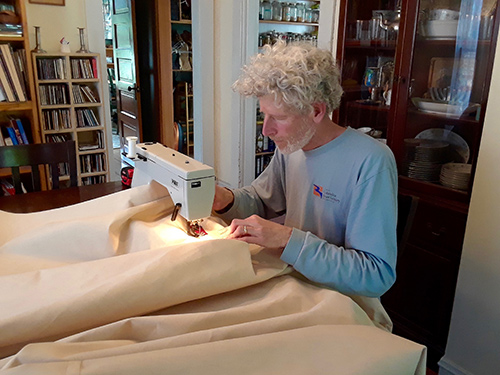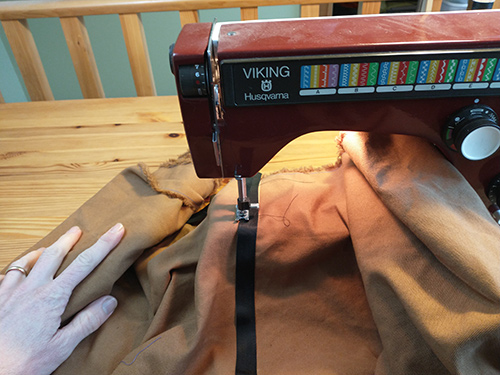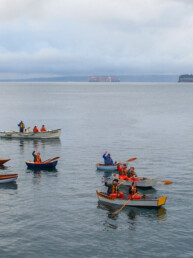
When I got over the jaw-dropping price of a bolt of Sunbrella fabric, I set aside my habitual thriftiness and pulled out my credit card. After all, I reasoned, once transformed into a boat cover, this long-lived material would protect my brightwork, keep me dry, and let my boat breathe during long winter days in the driveway. Then, after making what seemed like a million measurements, I sat down at my sewing table and set to work.
The scene in my craft room was far from typical, as I was well aware. Most sailors seem to be men, and although some I know can sew, many more take their canvas needs to a sail loft or a canvas shop. I’ve often thought that sailing would be more interesting if it wasn’t mostly a bunch of dudes enjoying beauty and peace on the water. Similarly, I think guys might benefit from venturing into territory long considered the province of women, and learning to use a sewing machine.
Although my mother always had a sewing machine in the house, I first learned to sew when I was putting together a small yawl-rigged wooden boat as an adult. It was about time to decide if I was going to hire a sailmaker or get a kit to sew. While worthwhile, the sailmaker was expensive, the kit less so — the only problem being that I’d never used a sewing machine in my entire life. Enter my then-new bicycling friend Andy Schmidt, who surprised me by announcing that he was a retired professional sailmaker, one who still owned commercial sewing equipment. He volunteered to help me make a suit of sails. Although Andy did most of the actual sewing, I learned every step of the process, which ignited my love of sewing.
Walking into a fabric store is walking into a woman’s world (often a middle-aged woman’s world), and I like it. I enjoy the variety of fabric colors and textures, the array of notions (zippers, buttons, threads, etc.), and I like the sense of possibility that these raw materials provide. I can make anything my imagination cooks up. There’s a more laid-back vibe in a fabric shop than in a sporting goods store, one where cooperation and mutual appreciation of skill contrasts with the brawn on display in the chandlery.
To be honest, what I like best of all at the fabric store is being the odd man out — literally. In a male-dominated world, it’s good to be reminded that not all spaces exist to make me comfortable and cater to people like me. Aside from the occasional husband along for Sherpa duty, I’m usually the sole guy. Toting my notebook of sketches and materials needs, I proceed joyfully through the store, sizing up materials, figuring out the perfect combination of things for my latest creation.
When unaccompanied by my own wife, I usually get a wary look from the workers — until I start talking shop. I love the look on their faces when they recognize that I know about hems, selvage, and zigzag stitches, and that I didn’t just wander in off the street. At that moment, I start to feel like a welcome part of the club.

A few years ago, when I went to buy fabric for a new cockpit tent, I described to the saleswoman what I was making. “This will be a Conestoga wagon-like design. I’ll place battens in pockets made with a modified French seam.”
“Oh, it’s so sexy when a man talks French seams,” she teased.
Ultimately, I found material I was excited about that day, and I appreciated the good fun, and the tips on pros/cons of various fabrics. But I left the store wondering: Where were all the men?
Andy is my sewing mentor, and the first man I met who could sew, so I rounded him up for a drink to see if he might be able to shed some insight.
“Hey, Andy,” I asked, “how’d you learn to sew?”
“I read Ray Jardine’s book about ultralight backpacking gear and got myself a thrift store sewing machine, so I could make my own stuff.”
From there, he told me, he got interested in boats and found that it was fun and inexpensive to do his own sewing, eventually getting into the business of sailmaking and custom canvas work. These days Andy runs Lord’s Luggage, where he’s applied some of his marine sewing skills to make bicycle and other adventure bags that have salty components, like sister clips — a type of hook used to attach items such as lines and flags — to seal the tops.
“Sewing is so cool, there are so many things you can make. Why do you suppose more guys don’t sew?” I asked.
“Well, there’s a stigma. I guess they just don’t consider it a masculine thing,” he said.
“Andy, since you taught me to sew,” I confessed, “I’ve never been short on ideas of outdoor gear I wanted to make or things I owned that I thought could be improved with a few additional stitches.”
We stared into our beers, considering everything our fellow men were missing by not learning how to wield a needle. Andy summed it up well, “Sewing is an opportunity for your imagination.”
On my way home, I wondered if men are just less imaginative, and therefore uninterested, or if the long tradition of women sewing was simply a cultural stereotype that was hard to buck.
In either case, I’m happy to spend my spare time wandering the aisles of women’s world, collecting the materials to fashion my creative projects.
And as for you men out there — you’re missing out!
Bruce Bateau sails and rows traditional boats with a modern twist in Portland, Oregon. His stories and adventures can be found at www.terrapintales.wordpress.com.
Bruce Bateau
Bruce Bateau sails and rows traditional boats with a modern twist in Portland, Ore. His stories and adventures can be found at www.terrapintales.wordpress.com






